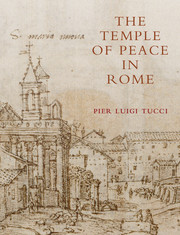Book contents
- Frontmatter
- Contents
- Preface
- Acknowledgments
- Abbreviations
- PART I The Templum Pacis in Context
- PART II Technical Analysis
- PART III The Great Hall in the Fourth Century
- PART IV AVLA DEI: The Basilica of Pope Felix IV (AD 526–530)
- CHAPTER 11 The Christian Basilica
- CHAPTER 12 The Mosaics
- PART V The Templum Pacis in the Middle Ages
- PART VI Between Renaissance and Baroque
- PART VII Modern Excavations and Restorations
- Conclusion
- Notes
- Bibliography
- Index (Names)
- Index (Places)
CHAPTER 12 - The Mosaics
from PART IV - AVLA DEI: The Basilica of Pope Felix IV (AD 526–530)
Published online by Cambridge University Press: 06 January 2018
- Frontmatter
- Contents
- Preface
- Acknowledgments
- Abbreviations
- PART I The Templum Pacis in Context
- PART II Technical Analysis
- PART III The Great Hall in the Fourth Century
- PART IV AVLA DEI: The Basilica of Pope Felix IV (AD 526–530)
- CHAPTER 11 The Christian Basilica
- CHAPTER 12 The Mosaics
- PART V The Templum Pacis in the Middle Ages
- PART VI Between Renaissance and Baroque
- PART VII Modern Excavations and Restorations
- Conclusion
- Notes
- Bibliography
- Index (Names)
- Index (Places)
Summary
THE GOAL OF THE present chapter is to highlight that the mosaics we see today in the Basilica of SS. Cosma e Damiano have been restored several times during the course of fifteen centuries. Some of these interventions have been misinterpreted or totally overlooked to date, but they should be taken into consideration very seriously. As noted in Chapter 11, the apse mosaic of the Basilica of SS. Cosma e Damiano (cfr. Fig. 244) shows the parousia – the Second Advent of Christ, predicted by Matthew's Gospel. Jesus, descending from colored layers of clouds, dominates the composition, in its turn dominated by God's hand. Saints Peter and Paul introduce Cosmas and Damian, who offer the crowns of their martyrdom. Further on the left is Pope Felix IVoffering a model of the basilica (Fig. 251, right). His present image is a seventeenth-century restoration, but a similar depiction dating from the sixth century appears at S. Vitale, in Ravenna. Symmetrically, Saint Theodore is on the right-hand side of the apse.The representation of post-apostolicmartyrs and of a patron pope does not appear in any known apse mosaics before this one, which indeed constitutes an iconographical turning point. The river Jordan, symbol of baptism, flows below Christ and separates the earthly world from the Promised Land. A mountain appears in the band below, from which the four paradisiacal rivers flow out and on which the Christological symbol of the mystical lamb stands out. Twelve lambs symbolizing the apostles are on his sides, six for each part, coming from Jerusalem and Bethlehem.
This composition, with monumental, three-dimensional figures, shows the persistence of classical art in the early sixth century. Note that these figures were the equivalent of the cult statues in Roman temples, with the basic difference being that they were not in the round and did not stand on a pedestal.
- Type
- Chapter
- Information
- The Temple of Peace in Rome , pp. 650 - 678Publisher: Cambridge University PressPrint publication year: 2017

